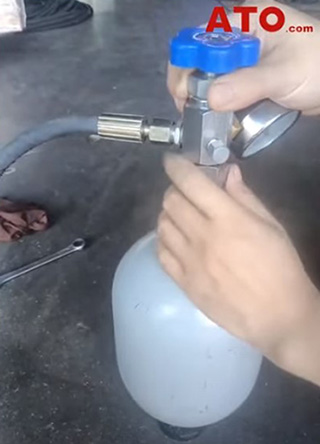How to Charge and Depressurize a Hydraulic Bladder Accumulator?
Hydraulic Bladder Accumulator is an important device used in hydraulic systems to store and balance hydraulic fluid pressure fluctuations. It usually consists of a shell, a diaphragm (bladder), and a storage medium (liquid or gas). The bladder is divided into two areas inside the accumulator: One is the liquid area, used to store liquids, the other is the gas area, which is used to store compressed gas (such as nitrogen).
A hydraulic bladder accumulator is a crucial component in hydraulic systems, used to store pressurized hydraulic fluid. Here is a step-by-step guide provided by ATO online shop on how to effectively charge and reduce voltage.
Charging Procedure
- Attach the Charging Assembly: Begin by attaching the charging assembly to the gas valve of the accumulator. Ensure the swivel nut is securely tightened.
- Positioning the Gas Chuck: During connection, keep the gas chuck handle in the center position to prevent accidental gas release. And then use a wrench to tighten the swivel nut. Turn the gas chuck fully clockwise (CW) until the pressure gauge begins registering pressure changes inside the accumulator.
- Checking Pressure: Monitor the pressure indicated on the gauge. Once the desired pressure is reached, proceed to the next step.
- Opening the Bleed Valve: To relieve internal pressure, open the bleed valve. You will hear the sound of pressure being released. Depressurize the hydraulic bladder accumulator completely to vent all trapped air.
- Continuing Monitoring: While depressurizing, observe the pressure gauge to ensure all air is vented. Maintain this setup until the pressure stabilizes and all air is expelled.
Depressurizing Procedure
- Removing the Gas Valve: Using a 17mm hex nut wrench, carefully unscrew the gas valve from the hydraulic bladder accumulator. Check for any remaining gas inside the vessel.
- Releasing Remaining Pressure: If there is residual pressure, you will hear a hissing sound from the outlet. Avoid removing the valve suddenly; instead, slowly release the gas by gradually unscrewing the valve.
- Completing Depressurization: Once all gas has been exhausted, safely remove the gas valve entirely. Replace the sealing washer and ensure the gas valve is securely tightened using a spanner wrench. After securing the components, reattach the charging rig to the valve. Ensure the gas chuck is centered before tightening the connection and closing the bleed valve.
- Nitrogen Charging: Attach a nitrogen hose to a nitrogen source, such as a nitrogen bottle. Slowly allow nitrogen gas to flow into the hydraulic bladder accumulator.
- Leak Check: Apply soap water evenly to the valve and the contact area between the washer and outlet. Watch for bubbles, indicating leaks. If no bubbles appear, proceed to verify pressure and check for leaks in the valve.
By following these procedures meticulously, you can effectively charge and depressurize a hydraulic bladder accumulator, ensuring optimal performance and safety in your hydraulic system.

